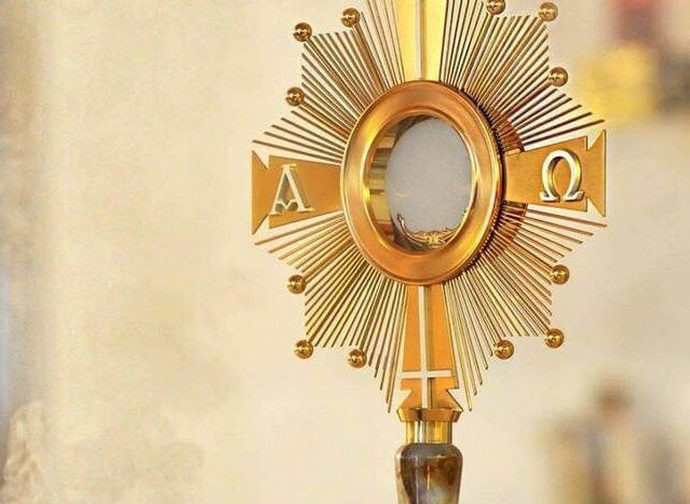Corpus Christi
“How did you extract a piece of a living heart from a person?” is the question posed in 2005 by Frederick Zugibe (1928-2013), an expert in forensic medicine and professor at Columbia University, after analyzing a fragment of a consecrated Host, which in 1996 had turned into bleeding flesh in the parish of Santa Maria in Buenos Aires...

“How did you extract a piece of a living heart from a person?” is the question posed in 2005 by Frederick Zugibe (1928-2013), an expert in forensic medicine and professor at Columbia University, after analyzing a fragment of a consecrated Host, which in 1996 had turned into bleeding flesh in the parish of Santa Maria in Buenos Aires. Professor Zugibe had received a sample of the Holy Particle, but without being told what it was. Years later the analysis, previously carried out by other scientists and always with the same results, showed that the sample was a vital fragment of the human heart. In particular, there was the presence of intact white blood cells and blood group AB, the same found by tests (the last of which was carried out in the 1970s) on the relics of the Eucharistic miracle of Lanciano, which occurred in the 8th century.
These facts help to recall the greatness of the mystery that the solemnity of Corpus Christi honours in a special way. It is the mystery of the Eucharist, the heart of our faith and the sacrament of sacraments instituted by Jesus at the Last Supper, as food and drink of salvation. It is precisely the solemn words of Our Lord, carved in all four Gospels and also transmitted by Saint Paul (Mt 26:26-29; Mk 14:22-25; Lk 22:19-20; Jn 6:53-58; 1 Cor 11:23-29), that leave no doubt about His real presence in the Eucharist. To this miracle, which actualizes Christ's sacrifice every time Mass is celebrated, the Church has given the name of transubstantiation, to express what happens at the act of consecration: the species of bread and wine, while maintaining their sensory characteristics, are converted entirely into the Body and Blood of Jesus.
The Solemnity of Corpus Christi was celebrated for the first time in 1247 in the diocese of Liège. At its origin there were the exhortations of Saint Juliana of Cornillon (c. 1192-1258), an Augustinian nun who around the age of 16 had a first vision, then repeated other times, while she adored the Blessed Sacrament. Juliana saw a moon in its full splendour, symbolizing the pilgrim Church on earth, crossed by a dark stripe, indicating the lack of a feast. As Jesus himself then explained to her, the feast would serve to increase the faith and make reparation for the offences against the Blessed Sacrament. For several years the saint spoke to no one of these revelations. She then decided to turn to some of the greatest theologians and ecclesiastics of the time (including the Archdeacon of Liège, Jacques Pantaléon, the future Urban IV), urging them to institute the feast, as the Bishop of Liège, Robert de Thourotte, was the first to do.
In 1263 the famous Eucharistic miracle of Bolsena took place. A Bohemian priest, Peter of Prague, came on pilgrimage to Italy because he was assailed by doubts about the real presence of Jesus in the Eucharist. These doubts vanished only after he had celebrated Mass in the church of Santa Cristina, in Bolsena: here, at the moment of consecration, the Host began to bleed on the corporal. Urban IV, who was in nearby Orvieto, immediately had the incident verified. The following year the same Pontiff charged St. Thomas Aquinas to write the liturgical office of Corpus Christi, giving the Doctor Angelicus the opportunity to compose sublime Eucharistic hymns, such as the Adoro Te devote, the Pange Lingua, the Sacris Solemniis and the Verbum supernum prodiens. Moreover, with the Bull Transiturus de hoc mundo (11 August 1264), he extended the solemnity to the whole Church, fixing it on the first Thursday after the Octave of Pentecost.
Thus wrote Urban IV in the bull: “Although the Eucharist is solemnly celebrated every day, we believe it right that at least once a year it should be more honoured and solemnly remembered. The other things that we remember, we grasp them with spirit and mind, but we do not in this way obtain their real presence. Instead, in this sacramental commemoration of Christ, though in another form, Jesus Christ is present with us in His own substance. For as he was about to ascend to heaven He said: Behold, I am with you every day until the end of the world”.
That is why Blessed Carlo Acutis (1991-2006) called the Eucharist “my highway to Heaven”. And, knowing that he could adore Jesus at any time in the silence of the tabernacle, he taught that we are luckier than the people who lived two thousand years ago in the Holy Land, because they had to constantly move to follow him, while we don't, because “Jerusalem is on our doorstep”.




